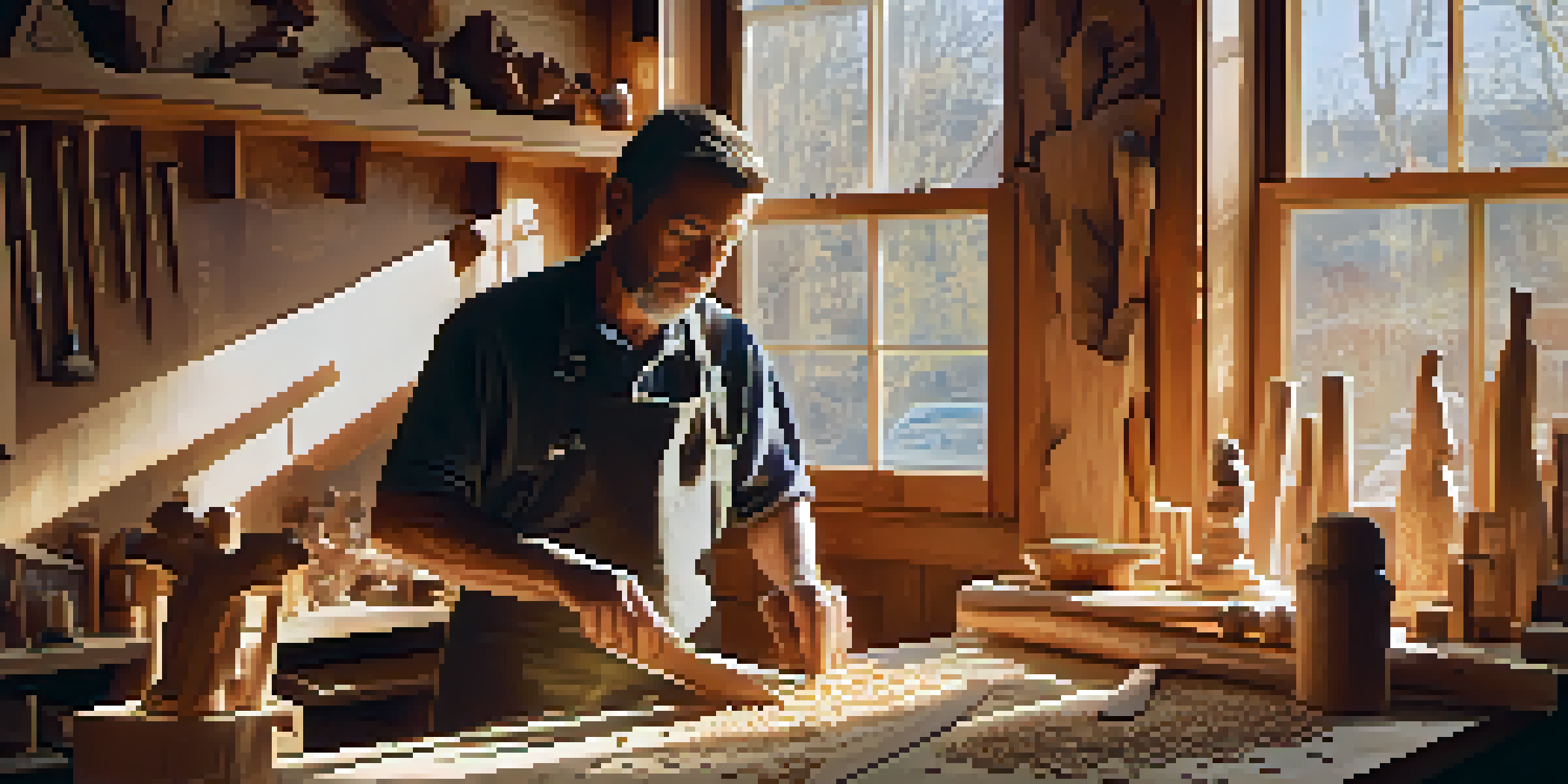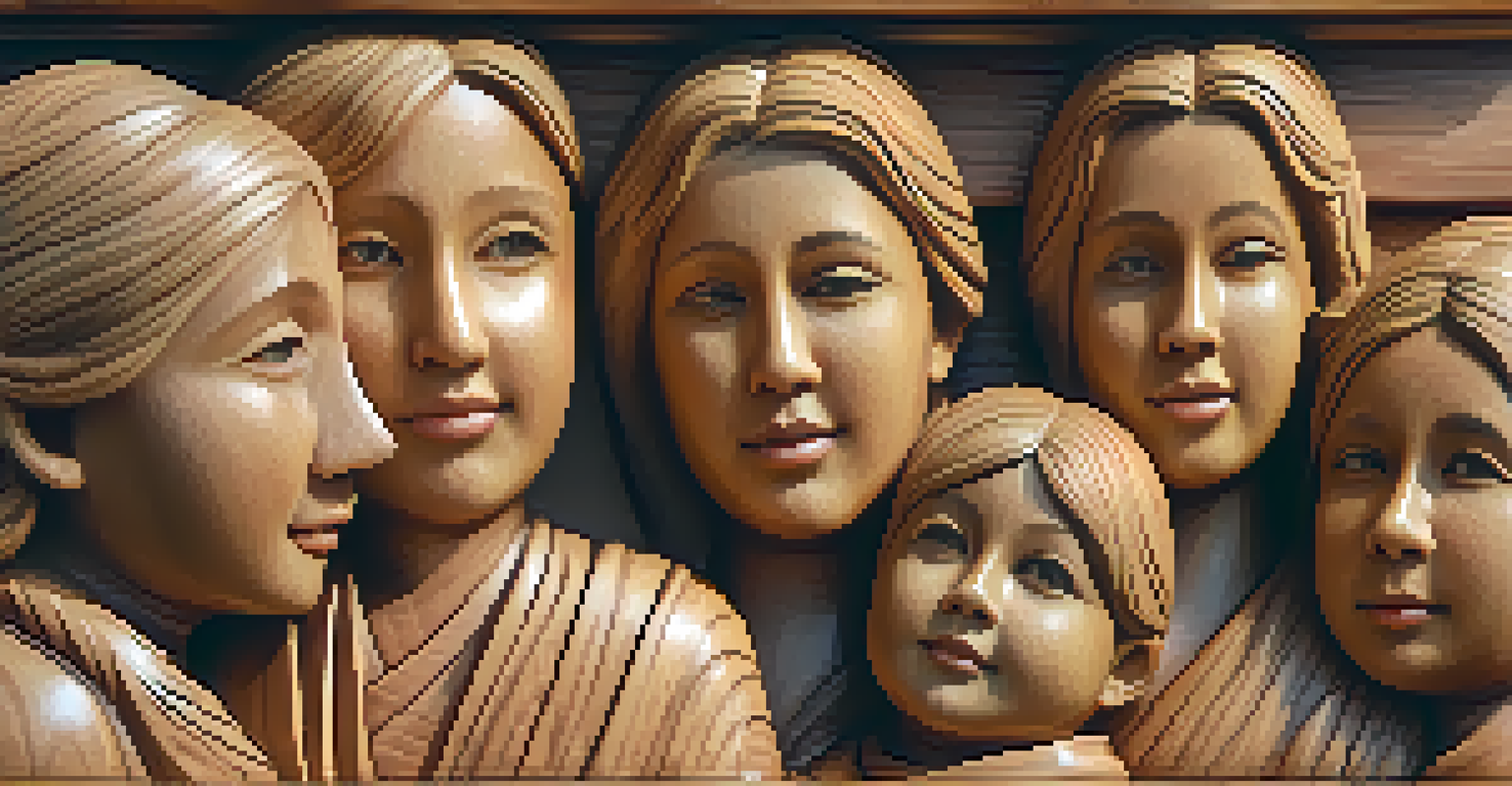Carving as a Narrative: Unveiling Stories in Wood

Understanding the Art of Wood Carving
Wood carving is an ancient craft that transforms a simple piece of wood into a work of art. Artists use various tools to shape and mold the wood, bringing out its natural beauty and unique grain patterns. This creative process not only requires skill but also a deep understanding of the material’s characteristics.
The process of carving is not simply about removing material; it's about revealing the story that lies within the wood.
Each piece of wood tells a story of its own—its age, texture, and color all contribute to the final artwork. Carvers often choose specific types of wood based on their desired outcome, whether it's the softness of pine or the sturdiness of oak. This connection to the material enhances the narrative potential of each carving.
As we delve deeper into the world of wood carving, we'll see how this craft goes beyond mere decoration. Carvings can evoke emotions, reflect cultural heritage, and even convey personal experiences, making wood not just a medium, but a storytelling canvas.
The Historical Significance of Wood Carving
Wood carving has a rich history that spans cultures and centuries, often serving as a means of communication. Ancient civilizations used carvings to depict their beliefs, rituals, and daily life, preserving narratives for future generations. For instance, the intricate carvings found in Egyptian tombs reveal insights into their afterlife beliefs.

In many indigenous cultures, wood carving is a vital form of artistic expression and storytelling. Totem poles, for example, are carved to represent tribal lineage and significant events, acting as visual narratives that convey history and identity. This tradition continues to thrive today, reminding us of our shared human experience.
Wood Carving as Storytelling Art
Wood carving transcends decoration, serving as a medium for emotional expression and cultural narratives.
Understanding these historical contexts enhances our appreciation of contemporary wood carvings. When viewing a modern piece, we can recognize the lineage of stories it might be echoing, connecting us to the past while celebrating the present.
Techniques That Bring Stories to Life
Carving techniques vary widely, each offering different ways to express a narrative. Subtractive carving, where material is removed to create a design, allows for intricate details that capture emotion and movement. On the other hand, relief carving provides a three-dimensional aspect, enabling stories to pop out from the background.
Wood carving is a journey of discovery, where each stroke uncovers the hidden beauty and narrative of the material.
Carvers often incorporate varying depths and textures to evoke different feelings. For instance, smooth surfaces can evoke serenity, while rough textures may suggest struggle or chaos. These choices are deliberate, as each stroke of the tool contributes to the overall narrative.
Additionally, the use of color can further enhance storytelling in wood carving. Stains and paints can bring a piece to life, adding layers of meaning and inviting viewers to delve deeper into the story being told.
Personal Narratives in Wood Carving
Many wood carvers choose to infuse their personal stories into their work, making each piece a unique reflection of their experiences. Whether it’s a family heirloom or a commissioned artwork, personal narratives can add profound depth to a carving. This connection between the artist and their work invites viewers to engage with the story behind the piece.
For example, a carver might create a sculpture that represents their hometown, incorporating local flora and fauna into the design. This piece not only captures the essence of their surroundings but also serves as a reminder of their roots and memories. Through these personal stories, wood carving becomes a powerful medium for self-expression.
Historical Roots of Wood Carving
The craft has a rich history, preserving cultural beliefs and stories across generations through intricate designs.
As we appreciate these personal narratives, we find common ground with the artist, sparking conversations and connections. Each carving can elicit emotions and memories in viewers, making the experience of engaging with art a shared journey.
Cultural Narratives and Their Representation
Wood carving is often a reflection of cultural narratives, embodying traditions, beliefs, and values. Different cultures have unique styles, motifs, and techniques that tell their stories. For instance, African masks are not only artistic expressions but also serve ceremonial purposes, representing ancestors and spiritual beliefs.
In contrast, Scandinavian wood carving often features intricate designs that tell tales of folklore and mythology. These cultural narratives provide a glimpse into the values and history of a community, preserving their legacy through artistry. Each carving becomes a vessel of cultural identity, inviting exploration and understanding.
As artists continue to draw inspiration from their heritage, they breathe new life into age-old stories. This blending of tradition and contemporary expression enriches the narrative landscape of wood carving, allowing us to appreciate diverse perspectives.
The Emotional Impact of Wood Carving
One of the most striking aspects of wood carving is its ability to evoke emotions. A well-crafted piece can resonate deeply with viewers, stirring feelings of nostalgia, joy, or even melancholy. Artists tap into universal themes—love, loss, celebration—which are often reflected in their carvings, creating a profound connection with the audience.
For instance, a carving depicting a family gathering can evoke memories of cherished moments spent with loved ones. This emotional resonance transforms wood carving from mere decoration into a powerful storytelling medium, capable of bridging time and space.
Future of Wood Carving Innovation
Emerging technologies and mixed media are transforming wood carving, expanding its narrative possibilities while maintaining its storytelling essence.
As we engage with these emotional narratives, we invite reflection on our own lives and experiences. The stories embedded in wood carvings remind us of our shared humanity, encouraging us to connect with others through the lens of art.
The Future of Wood Carving as a Narrative Medium
As we look to the future, wood carving continues to evolve as a narrative medium. Artists are experimenting with new technologies and materials, blending traditional techniques with modern innovations. This fusion opens up exciting possibilities for storytelling and expression, allowing for greater creativity and reach.
Emerging trends include the incorporation of mixed media and digital elements, expanding the boundaries of what wood carving can be. Artists can now create interactive sculptures or even integrate sound and light, adding new dimensions to their narratives. This evolution keeps the art form fresh and relevant in a rapidly changing world.

Despite these advancements, the core essence of wood carving remains unchanged: the ability to tell stories. As long as there are artists passionate about sharing their narratives, wood carving will continue to be a compelling medium that captures the imagination and connects us all.